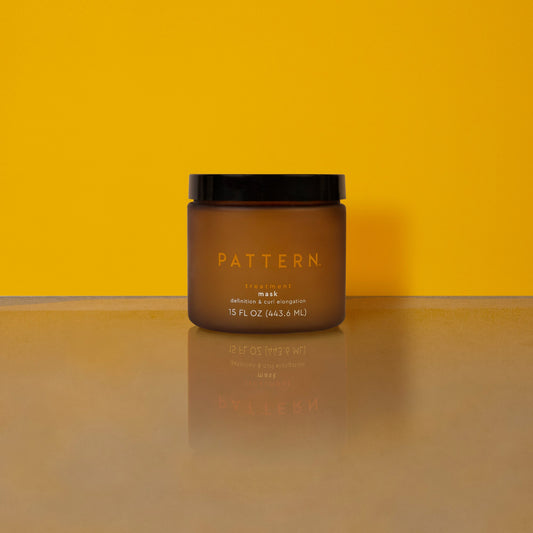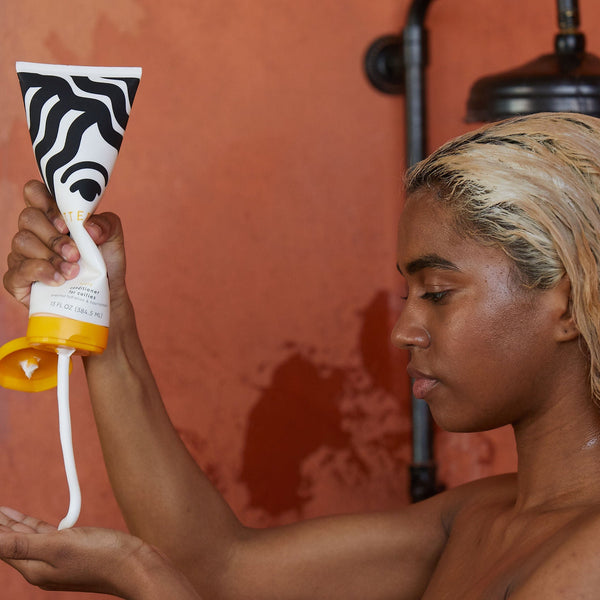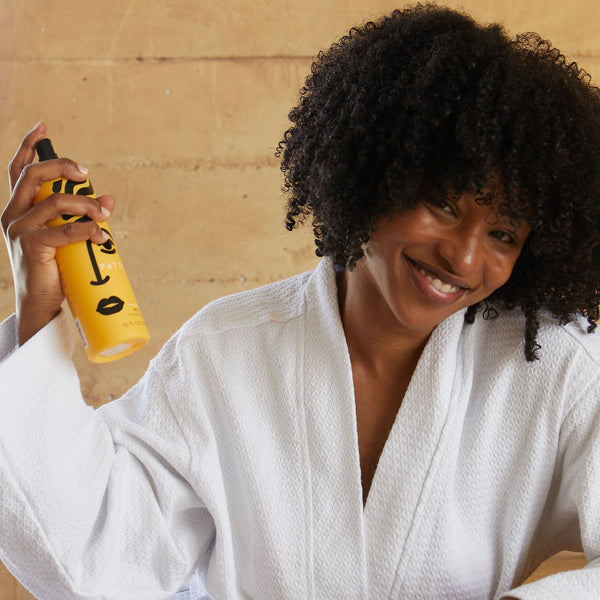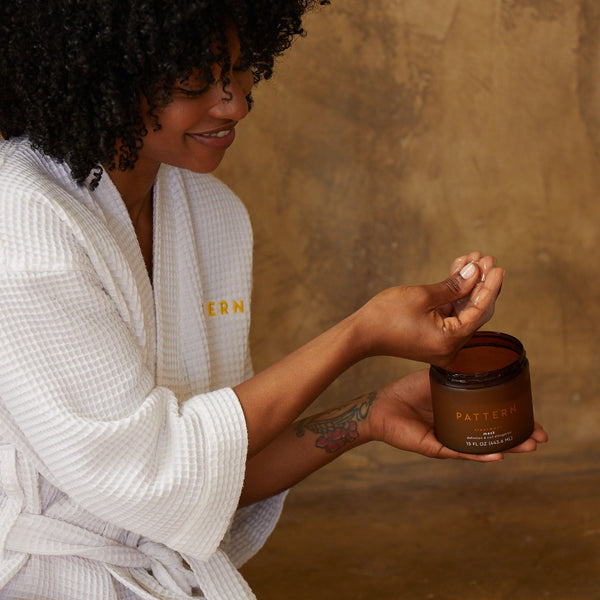When you’re winding down for bedtime & it’s time for a night cap, what’s the best way for you to close out your evening? Do you reach for a cup of tea or glass of cognac? Hit play on a true crime podcast or midnight Bridgerton binge? & of course, do you wrap things up with a silk or satin bonnet?
When learning how to wrap your hair, choosing the right curly hair accessories & a fabric that can cradle (and not crush) your curls is a key component in caring for natural hair, but the answer doesn’t always seem straightforward. When it comes down to it, both fabrics can nurture your curls so they spring into action (maybe before you do!) by sunrise.
Below, we’ll compare the satin vs silk bonnet debate so that you can narrow down the right curly hair products to lock in your unique pattern.
Silk vs Satin: What’s The Difference?
At first blush, satin & silk can look like dead ringers for one another: both sheeny, lustrous-looking fabrics that are known to treat curly, coily, textured hair with the care they deserve.
But before we weigh out the pros & cons of silk vs satin bonnets, let’s make like your ringlets & define our terms:
- Silk is a type of natural fiber. It’s made from the same fine strands silkworks create to weave their cocoons.
- Satin is a pattern of woven fabric—the way threads are arranged into a textile for a lustrous, touchable, silk-like feel.
There is one misnomer to keep in mind while shopping around for your bedtime bonnet: sateen. Sateen is made of cotton—a type of fiber that is known to hold onto bacteria, rough up the hair cuticle & physically damage the structure & texture of your coils.1
Long story short, both silk & satin bonnets can be a boon to your hair. Sateen, however, is a much better fit for your lingerie drawer than your locks, so check your labels before you purchase.
5 Benefits of Swaddling Your Curls In Satin
At the end of the day, both silk & satin can be excellent types of fabric to choose for your evening hair bonnet, but there are some benefits that may give satin an (oh-so-soft) edge.
Let’s review.
#1. Satin is Minimally Absorbent
In practice, achieving luscious curls can be a journey. In theory, however, the recipe for luscious curls is relatively simple: moisture, moisture, moisture.
The more nourished & hydrated curls are, the healthier they’ll look & feel. Silk tends to be a moisture-wicking textile, which may put your pattern at risk of waking up thirsty.1
Satin, in contrast, is a minimally-absorbent fabric, which means it won’t suck the natural moisture from your curls or soak in any product you’re wearing to bed.2
Translation? Satin indulges your coils in maximum nourishment, bounce & joyfulness.
#2. Satin Leads to Fewer Tangles
Very few of us stay perfectly still throughout the night as we sleep—chances are you shift about in bed during the wee hours. Tossing & turning is one of the primary reasons why our curls tend to tangle so learning how to protect curly hair at night is a must.
Satin, however, is a low-impact fabric, which leads to:2
- Less friction & damage to your hair shaft
- Reducing the time you’ll spend detangling your hair
- Less unintended frizz to sculpt in the morning
#3. Satin Lets Your Curls Live
Don’t let silk’s finespun strands fool you: this natural fiber is a remarkably textured fabric. While silk is considered a luxury textile, it may be rougher to the touch—and may wind up being a little too harsh on natural hair patterns.
A satin hair bonnet, on the other hand, is supple & lightweight, renowned for its pliability & smoothness. Worn as a bonnet, it adapts & shapeshifts with the unique pattern of your living texture, preserving your shape without compressing your ringlets no matter how you’re styling on any given Sunday.
When choosing a nightly bonnet to supplement your curly hair night routine, selecting a sleep cap that won’t crimp your curls’ style is key. A satin bonnet has just a bit more give to it, which means your curls are free to assume their natural texture.
#4. Satin Is Easy to Care For
Ultra-luxe fabrics like silk tend to be ultra-high maintenance. As a synthetic fiber, satin is much easier to care for, leaving you with more time to devote to your pièce de resistánce: your hair.
Typically, satin bonnets need only be gently machine-washed around every 1-2 weeks, while a silk bonnet may require some extra elbow grease to keep it stain- & odor-free. If you’re looking for a simple way to preserve definition without compromising on quality, satin is your #1.
#5. Satin Keeps Your Wallet Happy
Silk comes at a far higher price point than satin because of how the textile is sourced (most commonly by mulberry silkworms).
Satin, in contrast, is a synthetic fabric, which means it’s far simpler to manufacture & therefore comes at a lower price point. Added bonus? Satin is vegan & cruelty-free—not to mention more wallet-friendly.
Cradle your curls with PATTERN’s Satin Cap
So, which reigns supreme: silk or satin for curly hair?
In the end, deciding between the two comes down to how much time, energy & money you're willing to invest. While a silk cap requires a hefty amount of upkeep, a satin sleep cap will save you time (and money) all while still putting your ringlets first.
Curly hair treatments are something you should do every month to keep your strands healthy. We recommend adding a sleep cap for curly hair to your treatment tool kit. PATTERN created a breathable& pattern-preserving Satin Cap that is a dream to slip into before your nightly Zzs, it’s the perfect crown to pair with your crown.
Sources:
- Engler, Alexandra. "Satin vs. Silk: Is One Material Better For Your Hair?" MBG Lifestyle. 13 July, 2021. https://www.mindbodygreen.com/articles/page-title-satin-vs-silk/
- Mitchell, Amanda. "Satin vs. Silk Pillowcases for Hair: What's the Difference?" Byrdie. Updated 1 March, 2022. https://www.byrdie.com/satin-pillowcase-for-hair-5189103





